One of the byproducts of doing research for my next two books, Where Did They Put the Gestapo Headquarters? A Walking Tour of Nazi Occupied Paris, is learning how many war criminals (Nazi as well as collaborators) were either never brought to justice or received relatively light sentences compared to the enormity of their crimes. Underground rat lines (click here to read Odessa: Myth or Truth) provided notorious Nazis with escape routes to South America. Protection was offered to some by Catholic Church officials. Many escaped during the chaos at the end of the war and returned to Germany to live out their remaining lives under either their given or assumed names. Politicians and government officials pardoned many of them after their convictions. However, it was only after 1998 that we became fully aware of the American, British, and Soviet recruitment of former Nazi scientists, engineers, and doctors during the immediate aftermath of the war. The American efforts were known as Operation Paperclip while the Soviet counterpart was Operation Osoaviakhim.
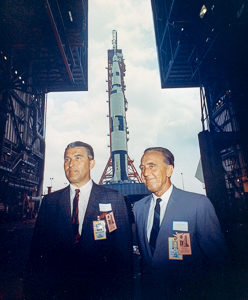
Did you Know?
Did you know the U.S. Government began declassifying World War II documents in the 1960s? However, it wasn’t until 1998 when President Clinton signed into law the Nazi War Crimes Disclosure Act that historians began to fully understand the involvement of the Allies in protecting certain Nazis who were clearly either directly or indirectly responsible for war crimes including crimes against humanity. The purpose of the act and its “Interagency Working Group” (IWG) was to fully disclose the remaining millions of pages of classified documents pertaining to war crimes committed by the Nazis and the Japanese. One of the results was the complete declassification of OSS documents (the OSS was the wartime American intelligence agency that morphed into the CIA after the war). The IWG also disclosed the involvement of the former Allied governments (United States, Britain, and the Soviet Union) in a post-war competition to see which country could recruit the most valuable Nazi scientists, engineers, technicians, and doctors. In all, the United States recruited more than 1,600 former Nazis while the Soviet Union forcibly recruited more than 2,200.
Subsequent Nuremberg Trials
After the first Nuremberg trial was finished (click here to read Court Room 600), some of the most ruthless and complicit Nazis captured by the Allies were tried in twelve Nuremberg follow-up trials for war crimes and crimes against humanity. Convicted defendants received prison sentences or were sentenced to death. However, in many cases, death verdicts were eventually reduced to life imprisonment and finally, to shorter and finite prison terms. Some were even given full pardons. By the mid-1950s, with the exception of the original Nuremberg prisoners in Spandau Prison, all imprisoned Nazis had been released including ten SS officers convicted and sentenced to death for their participation in the Einsatzgruppen (mobile SS death squads). Two men recruited by Operation Paperclip, Kurt Blome and Otto Ambros, went to trial. Included in the Doctors’ Trial (Case 1) was Dr. Blome, responsible for all Nazi biological warfare research while Ambros was a defendant in the I.G. Farben Trial (Case 6). We will meet both of these men later.
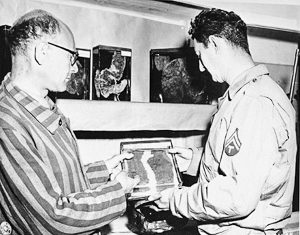
From the end of the war to around 1959, there were several categories of ex-Nazis who hid from justice with the assistance of the United States government. They included the scientists and engineers who worked on the development of V-2 rockets in Peenemünde and later, Nordhausen-Mittlewerk-Dora as well as the doctors who developed biological germ warfare.
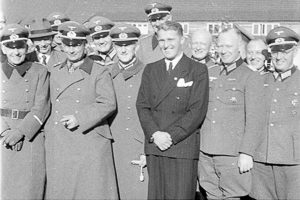
The Hierarchy and Operation Overcast
During the summer of 1944, the Americans and British established the “Combined Intelligence Objectives Subcommittee.” This joint effort reported directly to General Eisenhower at SHAEF and its purpose was to identify and seize critical documents pertaining to the Nazis’ programs dealing with rocketry weapons, weapons of mass destruction, and the development of a nuclear bomb. As the Allies pushed deeper into the occupied countries and ultimately, Germany, they knew it would be critical to obtain this documentation. They estimated the Nazis employed more than 3,000 scientists, engineers, doctors, and technicians to accomplish their goal of winning the war for Hitler and Germany.
One of the most important sub-groups under the American Joint Chiefs of Staff (JCS) was the Joint Intelligence Committee (JIC). One of its reports to the JCS declared that war with the Soviet Union would begin in 1952. The top brass in the military then realized they would be competing with the Soviets for Nazi scientific talent, their research, and strategies the Nazis were following.
In July 1945, the JCS approved a clandestine operation: “The Nazi Scientist Program.” It was to recruit, utilize, and control a group of designated ex-Nazi scientists, engineers, doctors, and technicians. These men were referred to as “eminent German specialists.” The operation’s code name was “Overcast.” Eight months later, it became known as “Operation Paperclip” named after the procedure of placing a paperclip on the folder of a former Nazi targeted for employment.
Peenemünde and Mittelwerk-Dora
At the end of 1942, Hitler approved mass production of Werner von Braun’s A-4 rocket which ultimately became the long-range rocket known as the V-2. Albert Speer (1905−1981; 20-years imprisonment), Minister for Armaments and War Production (click here to read The Good Nazi), was responsible for the rocket program. Production was centered at Peenemünde until August 1943 when the RAF and its Operation Hydra bombed the research and production facility. Speer moved the V-2 production to an underground complex known as Mittelwerk, or Central Works. It was inside a mountain and consisted of crisscrossing tunnels. Slave labor was imported from the nearby KZ Mittelbau-Dora concentration camp for which Speer paid Himmler and the SS a daily fee for each prisoner. Approximately one-third of Mittelwerk’s forced labor or 20,000 laborers died from asphyxiation, malnutrition, beatings, and executions. It was a planned program whereby extermination was accomplished by forced labor.
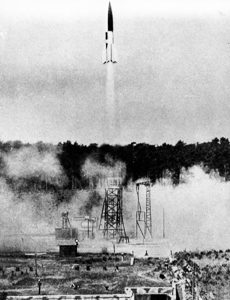

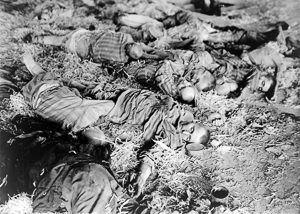
In charge of Mittelwerk’s operations was Georg Rickhey (1898−1966; acquitted). Arthur Rudolph (1906−1996; not tried) was responsible for the V-2 missile production at Mittelwerk. Walter Dornberger (1895−1980; not tried) led the ballistic missile program at Peenemünde and later, Mittelwerk until being replaced by SS General Hans Kammler. Kurt Debus (1908−1983; not tried) was an SS officer appointed to oversee the V-2 flight tests. All four of these men followed Wernher von Braun (1912−1977; not tried) to the United States under the protection of Operation Paperclip.
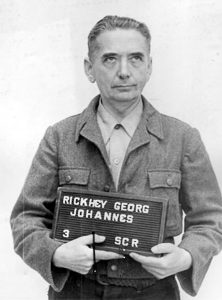
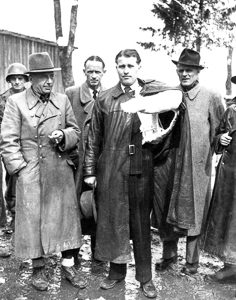
Rickhey was ultimately arrested and sent back to Germany where he stood trial during the Dachau Trials of 1947. After being acquitted, Rickhey never returned to the United States. Rudolph, along with von Braun, was one of the founders of the modern space program. He developed the Pershing missile and the Saturn V Moon rocket. He had been an ardent Nazi and by 1979 was being investigated by the Office of Special Investigations (OSI) for his role in the treatment of prisoners at Mittelwerk. He was stripped of his U.S. citizenship and deported to Germany where he died a free man. After Operation Paperclip, Dornberger went to work for Bell Aircraft Corporation until his retirement and ultimate return to Germany. Debus became the first director of NASA’s Launch Operations Center. He directed the design, development, construction, and operation of the Saturn launch facilities. Wernher von Braun became known as the father of the US space program and quite a celebrity in America.
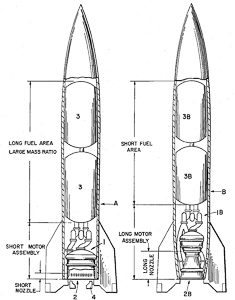
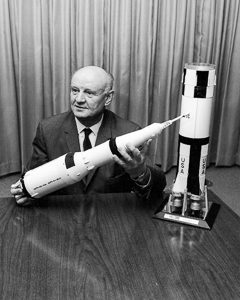
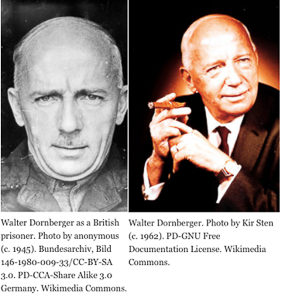 These are just a few of the former Nazis who developed the V-1 and V-2 missiles which killed approximately 9,000 civilians and military personnel. It’s ironic that more people died building the rockets than those directly killed by the rockets. Evidence is extremely strong that these men were aware of and condoned the forced labor and harsh treatment, including executions.
These are just a few of the former Nazis who developed the V-1 and V-2 missiles which killed approximately 9,000 civilians and military personnel. It’s ironic that more people died building the rockets than those directly killed by the rockets. Evidence is extremely strong that these men were aware of and condoned the forced labor and harsh treatment, including executions.
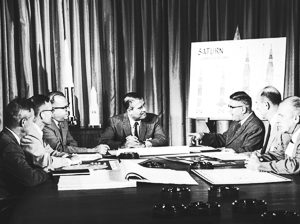
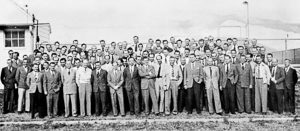
Biological Weapons of Mass Destruction
As bad as the ballistic missile development programs were with respect to the forced labor issues, the human experiments performed on the inmates of concentration camps were far more deplorable. Many of the doctors who participated in these experiments were put on trial in what became known as the “Doctors’ Trial.” Twenty-three defendants were tried with seven receiving death sentences and executed. One doctor who was acquitted was Kurt Blome. Watch Hitler’s Biological Soldiers video here.
Dr. Blome (1894−1969) was responsible for all biological research sponsored by the Wehrmacht and the SS. It is recognized that he personally participated in experiments on prisoners. His acquittal was likely orchestrated by the United States and saved him from execution. Blome’s specialty was biological warfare agents such as plague, cholera, anthrax, and typhoid. His human experiments included infecting prisoners to test for vaccines. He also tested nerve gases such as Tabun and Sarin on Auschwitz inmates.

Otto Ambros (1901−1990; 8-years: served four) was in charge of I.G. Farben’s synthetic rubber manufacturing facility known as Auschwitz III-Monowitz concentration camp. Prior to that he was responsible for the development of the deadly nerve agents Sarin, Soman, and Tabun. He oversaw the use of forced labor as well as human experiments.
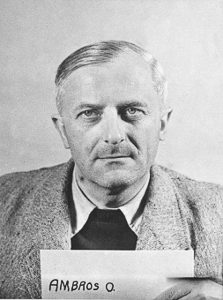
Hubertus Strughold (1898−1986; not tried) studied the medical effects of high-altitude and supersonic travel on individuals by using a pressurized altitude chamber to subject the victims to altitude changes and record the effect—most died. By 1942, Strughold became aware of the experiments on Dachau inmates using freezing water for hypothermia, being placed in air pressure chambers, and various surgical procedures including poison injections. After his capture, he denied any knowledge of the Dachau experiments despite evidence to prove otherwise.
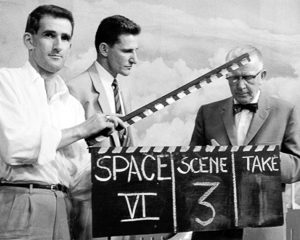
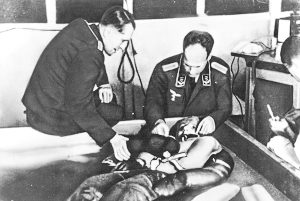
Blome was hired by the U.S. Army Chemical Corps to work on chemical warfare projects. He finally moved to West Germany where he worked as a physician and became active in right-wing politics. Ambros was captured and put on trial (known as the I.G. Farben Trial). He was found guilty and served only four years of his 8-year sentence. Ambros would later become an advisor to the U.S. Army Chemical Corps in addition to advising well-known chemical companies and West German politicians. Strughold continued his high-altitude research under Operation Paperclip and the supervision of the United States. He became known as “The Father of Space Medicine.” However, it was only after his death and the release of classified information which revealed Strughold’s complicity in the deaths at Dachau.
The Conundrum
After becoming acquainted with the story of Operation Paperclip, the natural reaction is to ask, “How could we have welcomed these men into our country after the horrible things they did under Hitler and the Nazi regime?”
Well, it’s the same conundrum when someone asks, “How could a person collaborate with the Germans?”
President Harry Truman authorized Operation Paperclip and he later explained that it was an easy decision. He reasoned that the Cold War and our relations with the Soviet Union demanded we use these men so they couldn’t work for the Soviets. Truman also justified his decision because of the future he saw in space exploration.
Should we have taken the moral path and punished these men or was Truman correct with his pragmatic decision? More than seventy-years later, it’s an easy choice for some and not so easy for others. I suppose it came down to either hanging ‘em or hiring ‘em with no in-between.
Jedem Das Seine
This was the German phrase cast in an iron gate above the entrance to the Buchenwald concentration camp. Its literal translation is, “To each his own.” However, the figurative meaning is, “Everyone gets what he deserves.”
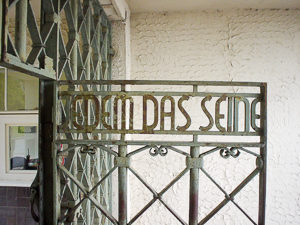
At the end of the first Nuremberg trial, it was clear that most Germans (including the defendants) believed this was the victor’s justice. No one would admit bearing any responsibility for the enormity of the war crimes and crimes against humanity perpetrated by Hitler and his Nazi regime.
The beginning of the Cold War and perceived threat of the Soviet Union, the desire to put World War II behind them, and need for highly skilled scientists and engineers created an atmosphere where the Americans and British governments made what they thought were pragmatic decisions concerning these former Nazis.
Right or wrong, there’s nothing we can do about it. The best thing we can do is teach our children about history’s greatest mass killing machine and how it evolved. The end result is to ensure we don’t forget because it can happen again.
Recommended Reading
Jacobsen, Annie. Operation Paperclip: The Secret Intelligence Program That Brought Nazi Scientists to America. New York: Little, Brown and Company, 2015. Watch Annie Jacobsen here.
Nazi War Crimes & Japanese Imperial Government Records Interagency Working Group: Final Report to the United States Congress, April 2007. Washington D.C.: National Archives, 2017.
Lichtbau, Eric. The Nazis Next Door: How America Became a Safe Haven for Hitler’s Men. Boston: Mariner Books, 2014.
The story of Operation Paperclip and related efforts to use former Nazis for technological advancements is so complex and interwoven that a single blog post cannot do justice to telling the full story. I have attempted to give you the back ground and highlight several of the Operation Paperclip scientists and doctors. Ms. Jacobsen and Mr. Lichtbau published their respective books around the same time. Each was extensively researched and received good reviews as well as becoming bestselling books. For the complete story of how our space program evolved from the ashes of The Third Reich, I highly suggest you read their books.
What’s New With Sandy and Stew?
I recently held a two-hour seminar on self-publishing and some of the pitfalls to watch out for. This was included in the weekly series sponsored by Florida Gulf Coast University (FGCU) as part of their adult outreach program called The Renaissance Academy. We had a good turnout even considering it was the “off season” here in Southwest Florida.
I’ve been asked to return and present three seminars during the first quarter 2019 which happens to be when all the snow birds flock to our little town. These discussions will be in a little different vein than most of the FGCU topics which tend to be “how to” subject matter. The director liked our blog posts and suggested we pick three to start off with.
So, at the end of January, we’ll treat the audience to the story of Sgt. Hilton Hilliard in Rendezvous with the Gestapo. Mr. Hilliard’s daughter, Ann, is planning to attend the seminar. Then towards the end of March, we’ll do Marie Antoinette’s Last Ride and Amazing Women of the French Resistance. I hope some of you will be able to join us. Let me know if you’d like to attend and I’ll send you the information.
Someone Is Commenting On Our Blogs
Thank you to Regan W. for her comments on Paris Therapy Pets. She voted for the Pied Piper. I thought that was a wise choice considering it would be the most environmentally friendly solution. Also, thanks to Jeanne C. for catching an editing boo-boo. It’s been fixed.
I hope many of you read a recent newspaper story about the squirrel that was carried onboard an airplane as a therapy pet. See, I wasn’t that far off in my blog, was I? If there is a topic you’d like to see a blog written about, please don’t hesitate to contact me. I love hearing from you so keep those comments coming.
Why Would You Want To Buy Our “Walks Through History” Books?
Simple.
You like to travel and experience history and historical events. You like to see original buildings that had a significant impact on the people and events of the history you’re engaged with. You want to know the stories behind the brick and mortar in front of you.
The walking tour books are meticulously researched so you can go directly to those sites and learn about the building’s history as well as an introduction to some of the more interesting people associated with it.
Thank You
Sandy and I appreciate you visiting with us. We have some exciting things on the horizon and we’ll keep you updated as we go along.
Share This:
Follow Stew:
Find Stew’s books on Amazon and iBooks.
Please note that we do not and will not take compensation from individuals or companies mentioned or promoted in the blogs.  Walks Through History
Walks Through History
Copyright © 2018 Stew Ross

For anyone interested in this topic I strongly recommend the book, ‘The Hidden Nazi’ by Dean Reuter. Reuter’s book tells the true story of SS General Hans Kammler (the man who made the Holocaust possible) and his escape from justice aided by the U.S.
Hi Martin; Thanks for reaching out to me. I was introduced to Kammler when I read “Operation Paperclip.” Unfortunately, the author did not spend much time on him. I’m looking forward to reading Reuter’s book. I appreciate the recommendation. Also, thanks for signing up as a subscriber to our bi-weekly blog site. STEW